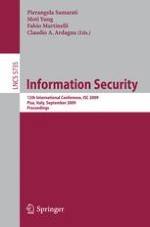This book constitutes the refereed proceedings of the 12th International Conference on Information Security Conference, ISC 2009, held in Pisa, Italy, September 7-9, 2009.
The 29 revised full papers and 9 revised short papers presented were carefully reviewed and selected from 105 submissions. The papers are organized in topical sections on analysis techniques, hash functions, database security and biometrics, algebraic attacks and proxy re-encryption, distributed system security, identity management and authentication, applied cryptography, access control, MAC and nonces, and P2P and Web services.
